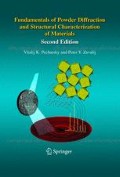As we established in Chaps. 7–9, the diffraction pattern of either a single crystal or a polycrystalline material is a transformation of an ordered atomic structure into reciprocal space, rather than a direct image of the former, and the three-dimensional distribution of atoms in a lattice can be restored only after the diffraction pattern has been transformed back into direct space. In powder diffraction, the situation is complicated by the fact that the diffraction pattern is a one-dimensional projection of a three-dimensional reciprocal space. We have no intention of covering the comprehensive derivation of relevant mathematical tools since it is mainly of interest to experts, and can be found in many excellent books and reviews.1 Therefore, in this chapter we only briefly describe a general approach to the problem of solving the crystal structure.
Access this chapter
Tax calculation will be finalised at checkout
Purchases are for personal use only
Preview
Unable to display preview. Download preview PDF.
10.4 Additional Reading
International Tables for Crystallography, vol. A, Fifth Revised Edition, Theo Hahn, Ed. (2002); vol. B, Third Edition, U. Shmueli, Ed. (2008); vol. C, Third Edition, E. Prince, Ed. (2004). All volumes are published jointly with the International Union of Crystallography (IUCr) by Springer. Complete set of the International Tables for Crystallography, Vol. A-G, H. Fuess, T. Hahn, H. Wondratschek, U. Müller, U. Shmueli, E. Prince, A. Authier, V. Kopský, D.B. Litvin, M.G. Rossmann, E. Arnold, S. Hall, and B. McMahon, Eds., is available online as eReference at http://www.springeronline.com.
P. Coppens, X-ray charge densities and chemical bonding. IUCr Texts on Crystallography 4, Oxford University Press, Oxford (1997).
V.G. Tsirelson and R.P. Ozerov, Electron density and bonding in crystals: principles, theory and X-ray diffraction experiments in solid state physics and chemistry, Institute of Physics, Bristol, UK (1996).
C. Giacovazzo, Direct phasing in crystallography: fundamentals and applications. IUCr monographs on crystallography 8, Oxford University Press, Oxford (1998).
T. Egami and S.J.L. Billinge, Underneath the Bragg peaks. Structural analysis of complex materials. Pergamon Materials Series. Pergamon, Amsterdam (2003).
R.B. Neder and T. Proffen, Fitting of nano particle structures to powder diffraction pattern using DISCUS, p. 49 in: CPD Newsletter “2D Powder Diffraction,” Issue 32 (2005), available at http://www.iucr-cpd.org/pdfs/CPD32.pdf.
Rights and permissions
Copyright information
© 2009 Springer-Verlag Berlin Heidelberg
About this chapter
Cite this chapter
(2009). Solving the Crystal Structure. In: Fundamentals of Powder Diffraction and Structural Characterization of Materials. Springer, Boston, MA. https://doi.org/10.1007/978-0-387-09579-0_10
Download citation
DOI: https://doi.org/10.1007/978-0-387-09579-0_10
Publisher Name: Springer, Boston, MA
Print ISBN: 978-0-387-09578-3
Online ISBN: 978-0-387-09579-0
eBook Packages: Chemistry and Materials ScienceChemistry and Material Science (R0)

